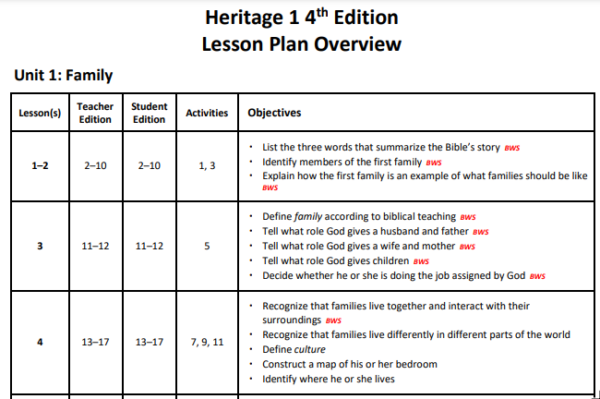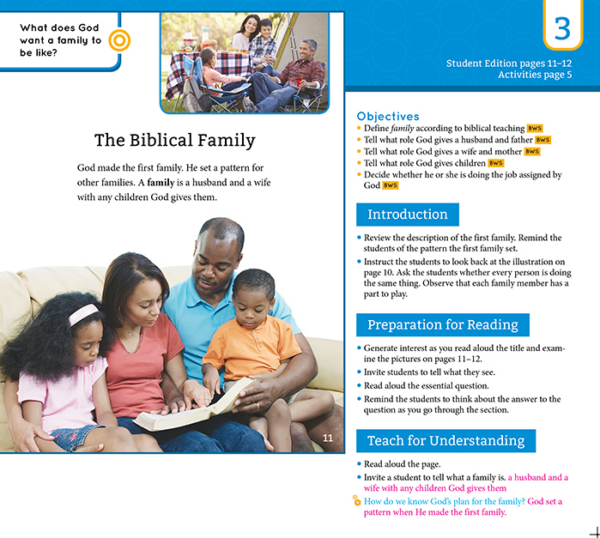
Creating a lesson plan for your homeschool can be a daunting project. If you have multiple children each with multiple subjects to plan, you might find yourself overwhelmed. Homeschool lesson plans do not have to consume all of your time. Homeschool lesson planners are available to automate and simplify the process of filling out your calendar with lessons. Many also find that relying on homeschool curriculum that include detailed homeschool lesson plans makes the planning process much faster. Read on to find out how to create lesson plans for your homeschool. As you make your own lesson plan, start with general overviews and chunk the project into smaller tasks.
What is a homeschool lesson plan?
A homeschool lesson plan gives a general overview of the big concepts your student needs to learn. It also encompasses specific daily plans for each subject. Lesson planning should connect each day’s learning to the larger overarching plan for the subject.
A Homeschool Lesson Plan vs. a Homeschool Schedule
What is the difference between a homeschool lesson plan and a homeschool schedule? A lesson plan is an outline of concepts and topics your student will learn, and when during the school year they will tackle each unit. A schedule is more about what time of day and how many days per week your student will work on each subject. Both are necessary, but we focus here on the lesson planning and refer to other resources for scheduling.
Do you need a homeschool lesson planner?
A homeschool lesson planner can help you stay organized and keep records of what your children are accomplishing. You might be able to accomplish what you need with a daily or weekly calendar, but homeschool planners may include additional features that will help you be successful.
The BJU Press Homeschool Hub offers free online homeschool planning no matter which curriculum you are using. It has many automated features for use with BJU Press textbooks and allows flexibility for you to modify your schedule as needed. You can even skip assignments that your children do not need. The hub can track your lesson plans, daily schedules, and grades, so there is no need to keep separate records anywhere else. The largest benefit of the Homeschool Hub is, when you use BJU Press textbooks or video courses, the planner will automatically create a homeschool lesson plan for each of your courses.
How to Create a Homeschool Lesson Plan
Start with one subject for one child. Most people like to start with the subject they find most familiar. Breaking up lesson planning in this way will chunk the project of lesson planning into smaller, more manageable tasks. You will need to repeat the steps for each subject for each child, unless they will have any shared subjects for the year. Involve your children in the planning as appropriate for their maturity level. This will encourage ownership of their education as they get older. It will also help prepare them for college, where they will need to determine what to study and when.
Create a Homeschool Calendar
It is helpful to know from the beginning how much time you will dedicate to schooling. If you follow a traditional school schedule, you will spend about half of the days of the year in school. Assuming you skip weekends, it will take about 36 weeks to reach the typical 180 days. As a homeschool parent, you have the flexibility to decide what works for your family. Will you use four days a week to have school and save one day a week for field trips and other activities? Do you have any family vacations planned? What other breaks will you want to take? Will you alternate on and off school all year long?
Once you have your calendar ready, you can determine how many weeks you have available to study each subject. If your calendar is the same for every child and every subject, you will only need to do this step once. If there are specific subject-related events you want to attend with only one child, be sure to account for those as you plan your calendar.
Choose Textbooks and Other Curriculum Materials.
Before creating a lesson plan for your entire year, you will need to have settled on the key parts of your curriculum. If you are using textbooks, will you supplement them with additional materials? Does your chosen curriculum provide lesson plans in its teaching materials? Are STEM learning activities incorporated into your curriculum or will you need to look for outside resources? Do your textbooks come with teacher resources? Are you participating in a homeschool cooperative or outsourcing some of the learning? The answers to these questions will inform what you need to do in the following steps.
Determine which Units and Chapters from the Textbook You Will Use.
If a textbook is driving most of your lesson planning, choose which units and chapters you will teach. Learning requirements for each grade level can inform your choice. You will also want to take into account topics within the subject area where your child shows special interest. If you are not following a set of textbooks like BJU Press, you will want to be sure you are building on what was learned the previous year and getting ready for what comes in the following year. Be sure to look at your state’s requirements for graduation when planning for your high schooler.
You may feel that you want to use every chapter from every textbook. Think back to your education. How many textbooks did you finish? Often seasoned teachers in a school setting are unable to finish the textbook, so you should not feel like you have to finish either. If you are supplementing with a lot of other resources, your use of a textbook might be limited. If you decided to build your own curriculum from non-textbook resources, you will need to rely on learning guidelines to help you determine what topics to include.
Align the Units and Chapters to the Homeschool Calendar.
Plan how the units and chapters you selected will align with the calendar. For example, if a textbook has 12 chapters, you will have approximately three weeks for each one. Some chapters might take more or less than three weeks, depending on your child’s skill level and interest. Now is the time to adjust those plans. Here is where you make your general overview of the school year for each subject as you map the big concepts onto your calendar. As you move between subjects, try not to schedule big projects or tests at the same time in multiple subjects. Be sure to leave time for extracurricular activities that relate to the topics you are planning.
As part of your scheduling process, you will also determine how many days per week you will address each subject area. If your teacher edition comes with lesson plans, you will have a good idea of how many days it will take for each unit. In younger grades, the daily subjects will include English language arts (reading, writing, and spelling) and mathematics. As students move up into middle and high school, they might tackle each subject every day, including history or social studies and science, leaving only electives as less frequent. Your high schooler might appreciate having some say in the planning, or some may be able to do it themselves.
Take an Individual Unit and Break It down into Lessons.
Here is where you get into the specifics about what each lesson will be. Each lesson should have a big idea that you want the student to grasp. It is up to you whether you do this more specific planning all at once, once a month, or on another schedule that works for you. Take into account your child’s learning style as you plan lessons and try new strategies to help them build concepts. One advantage to planning the specifics one week or one month at a time, is that you have the opportunity to adjust to what is working well or not working for your child.
Education majors in college learn how to create lesson plans with specific objectives. They also learn how to tie those objectives to the various levels of learning, such as knowledge, comprehension, application, analysis, synthesis and evaluation. If you are interested in these tools, you can familiarize yourself with Bloom’s taxonomy. It’s a great reference, but not entirely necessary. It is up to you whether you want to use that much detail in your lesson planning. Textbooks might already include objectives for each chapter. At a minimum, the lesson plan should include what pages of the textbook you will use and any other materials you will need to gather for the day. Look for tips for lesson instruction, especially for core subjects such as reading and mathematics. If you are using BJU Press materials, lesson plans are provided in the teacher edition, so your task here will be to decide when to use the provided plans and whether to skip or combine any of them.
Tips for Homeschool Lesson Planning
Homeschool Preschool Lesson Plans
Preschool lesson plans should focus on learning through play. Since preschool can encompass all years before formal education begins, we’re specifically talking about the K3 and K4 years here. Lesson plans should include games and activities that help develop these important skills:
- Fine motor skills. Holding a pencil or crayon correctly and using scissors are some examples of fine motor skills that children should develop by the end of preschool.
- Gross motor skills. Preschoolers develop gross motor skills while sitting, standing, walking, running, jumping, climbing, squatting and skipping. Outdoor play is an important part of their day. Crossing the midline activities are crucial for developing skills that require coordinating both sides of the body.
- Counting. Preschoolers should be able to recognize numbers, dot patterns, and be able to count items one by one. They should also start to skip count by the end of the year.
- Sorting. Sorting is an early math skill. Objects are sorted or ordered by a number of attributes including size, shape and color.
- Early literacy skills. Preschoolers should develop awareness that letters form words and that words have meaning. They should be able to answer questions about a story they have heard. They should begin learning letters and the sounds they make, and start to hear different sounds, such as rhyming and blending sounds.
Homeschool Kindergarten Lesson Plans
Kindergarten lesson plans might start to be more focused, but will still include a lot of learning through play. In kindergarten, the year before your child begins first grade, your child should develop additional skills they will need:
- Listen and follow directions. By the end of kindergarten, your child should be able to spend stretches of time focusing, up to 15 minutes. She should also be able to follow simple directions.
- Enthusiasm about learning. A child who is ready to learn more will be more successful in school.
- Reading skills. Kindergarten children will start to recognize words that occur frequently and might even start reading.
- Handwriting. Kindergarten students should be able to print upper- and lower- case letters and numbers 0–9.
- Math skills. Simple addition and subtraction and some basic measuring skills should be part of the kindergarten curriculum.
Homeschool Elementary Lesson Plans
- Connect topics to prior learned content. Children develop foundational skills in preschool and kindergarten, and you can start to connect new concepts to old frameworks the children have and deepen their understanding.
- Begin to increase focus time as students mature. Your planned activities and lessons can stretch a bit longer.
- Include engaging activities. At any age, engage students in active learning whenever possible.
- Begin to assess student learning. During the elementary years you will start to assess student work by giving grades for assignments—it is up to you whether you assign grades for practice sheets, tests, projects, activities, or just general observation of competancy. Older elementary students will be ready for more tests.
Homeschool Middle and High School Lesson Plans
In addition to the points above for elementary lesson plans, middle and high school lesson plans have additional features:
- Shift to more independent learning. Your middle and high school students are capable of reading a textbook and answering questions independently. They will still benefit from engaging activities, but might not need as many of them.
- Include more assessments. Reading quizzes, tests, and projects will make up more of a student’s overall grade in middle and high school.
- Begin to teach time management. Allow your high school children some more oversight of their own time management.
Homeschool Lesson Plan Examples
For homeschool lesson plan examples, take a look at the BJU Press Heritage Studies 1: Family and Community teacher edition. BJU Press provides two types of lesson plans in the teacher editions. A lesson plan overview is a quick look at the lesson, the corresponding teacher edition and student edition page numbers, the activity book page numbers, and the objectives for that lesson. These quick lesson plans are great if you like to be more extemporaneous with your teaching style.

For more detailed lesson plans, the margin notes on the lesson pages of each teacher edition restates the objectives, instructions for what to cover, and questions to ask your children to help with teaching.

Essentials for Homeschool Planning
In addition to a good homeschool curriculum, see above, you will also need a way to keep records. If you are using a planner, whether digital or on paper, the planner can serve as your record of what your child has accomplished. You might use these records for reporting to the state, if that is required. You will need your records when it comes time to make a transcript for your high school student.
• • • • •
Valerie is a wife and a mother to a very busy preschooler. In her free time she enjoys reading all kinds of books. She earned a B.S. in Biology from Bob Jones University, minoring in Mathematics, and a Ph.D. in Molecular Genetics from Ohio State University. Valerie has 15 years of experience working in research laboratories and has coauthored 8 original research articles. She has also taught several classes and laboratories at the high school and college levels. She currently works as a Data Analyst and a freelance writer.
Leave a Reply